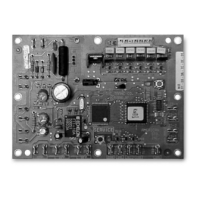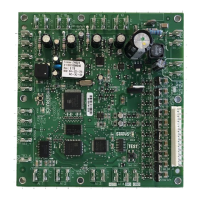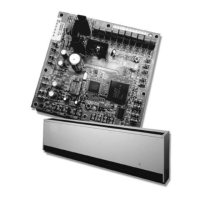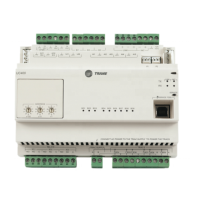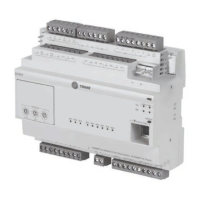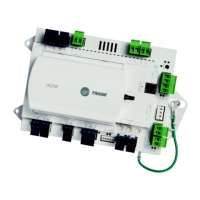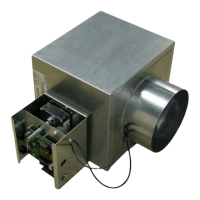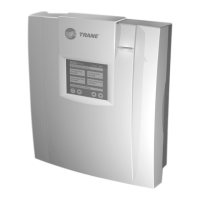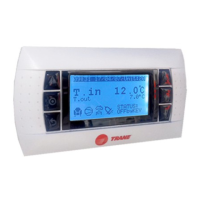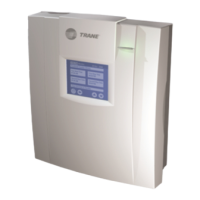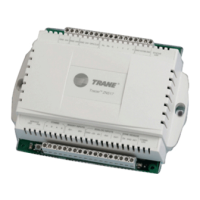
Do you have a question about the Trane Tracer ZN517 and is the answer not in the manual?
| Brand | Trane |
|---|---|
| Model | Tracer ZN517 |
| Category | Controller |
| Language | English |
Details the Tracer ZN517 as an application-specific controller for zone temperature control, operating standalone or as part of a BAS.
Provides physical dimensions for plastic-cover and metal-cover models and required installation clearances.
Specifies power requirements for the controller and its operating environment conditions for temperature and humidity.
Outlines requirements for storing the controller and lists agency listings and compliance standards.
Lists the default temperature setpoints configured at the factory for various modes, editable via service tool or BAS.
Details components required for proper operation that are not included with the controller, such as transformers and sensors.
Provides guidance on optimal placement for rooftop and heat pump applications for reduced wiring and accessibility.
Offers specific advice for securely mounting the controller, including orientation and fastener considerations.
Details required controller inputs and optional inputs/outputs for 2-heat/2-cool applications, with wiring diagrams.
Explains how to set DIP switches on the circuit board for the 2-heat/2-cool configuration, with and without economizer.
Describes the function of each of the eight binary outputs for 2-heat/2-cool applications, including Binary Output 5.
Details the two binary inputs (BI1, BI2) and their functions for occupancy or generic use and fan status.
Explains the five analog inputs (AI1, AI2, DAT, ZN, SET) and their configurations and measurement ranges.
Covers the ZN analog input for zone temperature and the SET input for temperature setpoint, including override functions.
Describes the step-by-step process the controller follows when initially powered on, including wait functions.
Explains Cascade Zone Control and Simplified Zone Control for maintaining zone temperature.
Details the different occupancy modes (Occupied, Unoccupied, Standby, Bypass) and how they are controlled.
Explains the economizing feature, which uses outside air for cooling, and its configuration requirements.
Covers discharge air tempering, demand control ventilation, and unit protection strategies like filter timers and fan status.
Details required controller inputs and optional inputs/outputs for 4-cool applications, with wiring diagrams.
Explains how to set DIP switches on the circuit board for the 4-cool configuration, with and without economizer.
Describes the function of each of the seven binary outputs for 4-cool applications, including Binary Output 5.
Details the two binary inputs (BI1, BI2) and their functions for occupancy or generic use and fan status.
Explains the five analog inputs (AI1, AI2, DAT, ZN, SET) and their configurations and measurement ranges for 4-cool.
Describes the step-by-step process the controller follows when initially powered on, including wait functions.
Explains Cascade Zone Control and Simplified Zone Control for maintaining zone temperature.
Details the different occupancy modes (Occupied, Unoccupied, Standby, Bypass) and how they are controlled.
Discusses the controller's support for modulating and two-position outdoor air damper actuators.
Explains how the controller manages fan operation, including continuous and cycling modes.
Explains the economizing feature, which uses outside air for cooling, and its configuration requirements.
Covers discharge air tempering, demand control ventilation, and unit protection strategies like filter timers and fan status.
Details required controller inputs and optional inputs/outputs for heat pump applications, with wiring diagrams.
Explains how to set DIP switches on the circuit board for heat pump configurations, with and without economizer.
Describes the function of each of the eight binary outputs for heat pump applications, including Binary Output 5.
Details the two binary inputs (BI1, BI2) and their functions for occupancy or generic use and fan status.
Explains the five analog inputs (AI1, AI2, DAT, ZN, SET) and their configurations and measurement ranges for heat pumps.
Describes the step-by-step process the controller follows when initially powered on, including wait functions.
Explains Cascade Zone Control and Simplified Zone Control for maintaining zone temperature.
Details the different occupancy modes (Occupied, Unoccupied, Standby, Bypass) and how they are controlled.
Explains how the controller determines the heating or cooling mode, whether communicated or automatic.
Explains how the controller manages fan operation, including continuous and cycling modes.
Explains the economizing feature, which uses outside air for cooling, and its configuration requirements.
Covers strategies like filter maintenance timer, fan off delay, and fan status to protect the unit or building.
Explains what PID loops do, how they maintain setpoints, and the effects of PID aggressiveness.
Details the proportional, integral, and derivative calculations used in PID control algorithms.
Discusses the importance of sampling frequency for achieving responsive and stable PID control systems.
Explains direct/reverse action and the use of error deadband to minimize actuator activity and cycling.
Provides a systematic procedure for troubleshooting PID loops, including checking settings and system disturbances.
Explains the function of the Test button and how to perform a manual output test for verifying operation.
Describes the function of the Service Pin button for network communication verification and device identification.
Provides explanations for the status indicated by the green, red, and yellow LEDs on the controller.
Details the types of diagnostics (informational, automatic) and how they affect controller operation and can be cleared.
Covers application-specific wiring for input/output terminals and general wiring specifications.
Explains wiring for packaged and split system HVAC units, including Rc and Rh terminal connections.
Provides essential precautions and specifications for connecting AC power to the controller.
Outlines requirements for LonTalk communication wiring and addressing for BAS integration.
Presents a sequence of preliminary steps to perform before diagnosing specific operational problems.
Provides tables to help diagnose common operational issues like fan or damper failures.
